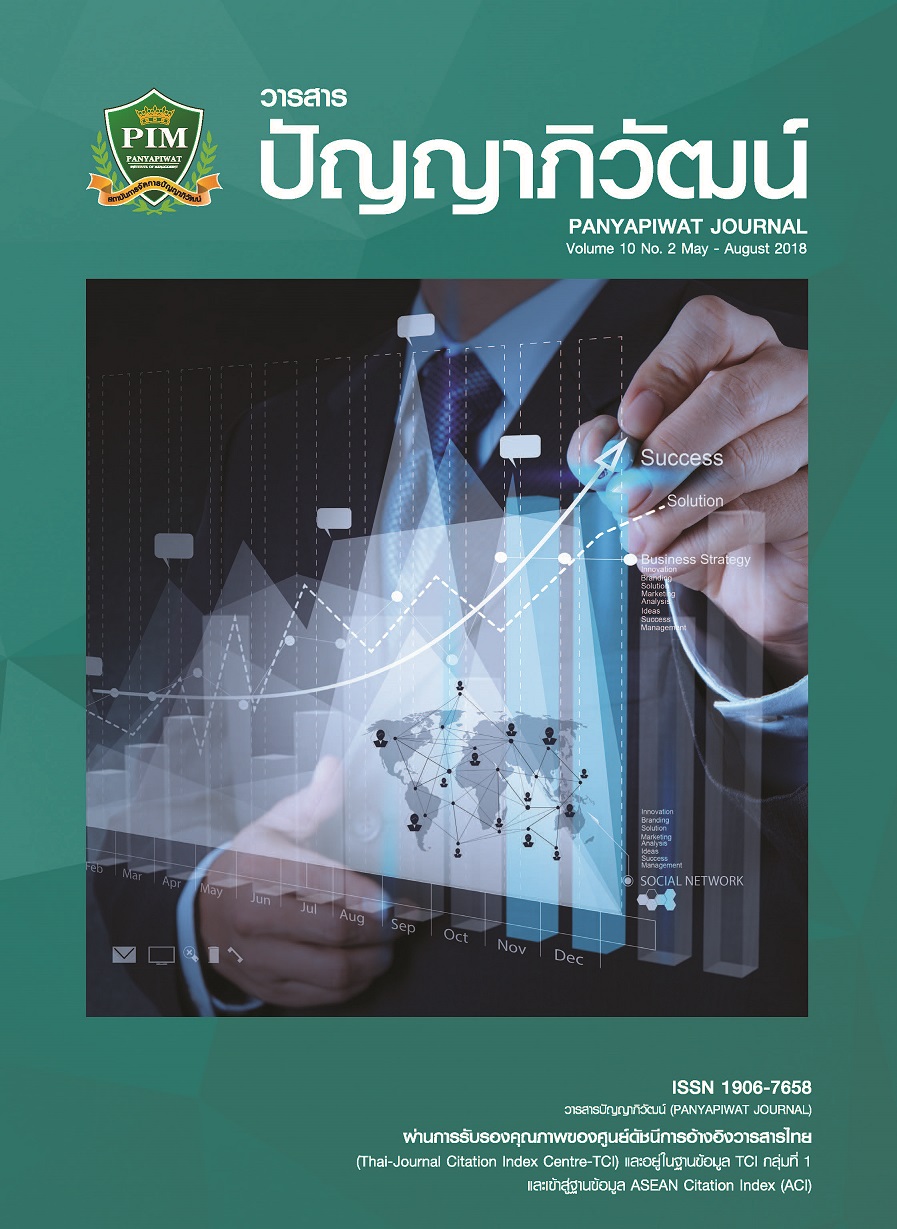การมุ่งเน้นกระบวนการปฏิบัติงานทางบัญชีและความสำเร็จทางการบัญชี: งานวิจัยเชิงประจักษ์ของอุตสาหกรรมขนาดกลางและขนาดย่อม ธุรกิจชิ้นส่วนยานยนต์ในประเทศไทย
Main Article Content
บทคัดย่อ
การมุ่งเน้นกระบวนการปฏิบัติงานทางบัญชีเชิงกลยุทธ์เป็นกระบวนการทางการบัญชี ใช้เป็นแนวทางในการทำบัญชีที่ให้ความสำคัญกับคุณภาพข้อมูลเพื่อช่วยในการตัดสินใจที่มีคุณภาพ งานวิจัยครั้งนี้มีวัตถุประสงค์เพื่อตรวจสอบผลกระทบของการมุ่งเน้นกระบวนการปฏิบัติงานทางการบัญชีเชิงกลยุทธ์และความสำเร็จทางการบัญชี โดยรวบรวมข้อมูลจากอุตสาหกรรมขนาดกลางและขนาดย่อม ธุรกิจผลิตชิ้นส่วนยานยนต์ในประเทศไทย จำนวน 305 กิจการ โดยรวบรวมข้อมูลจากการสำรวจทางไปรษณีย์ภายในระยะเวลา 2 เดือน (กุมภาพันธ์-มีนาคม 2558) ผู้ตอบแบบสอบถามคือ ผู้จัดการฝ่ายบัญชี โดยใช้การวิเคราะห์ถดถอยที่ใช้วิธีกำลังสองน้อยที่สุดในการวิเคราะห์ข้อมูล ผลการวิจัยพบว่า การมุ่งเน้นหลักฐานรายการค้าและการตระหนักถึงการเชื่อมโยงข้อมูลทางการบัญชี มีอิทธิพลในเชิงบวกต่อความเป็นเลิศในหน้าที่ทางการบัญชี คุณภาพข้อมูลทางการบัญชี และประสิทธิผลการปฏิบัติทางการบัญชี นอกจากนี้ยังพบว่า การเน้นความชัดเจนกระบวนการทางบัญชีมีอิทธิพลในเชิงบวกต่อคุณภาพข้อมูลการบัญชี อีกทั้งการให้ความสำคัญกับนโยบายบัญชี และการเน้นการรวมกฎระเบียบทางบัญชี มีอิทธิพลในเชิงบวกต่อความเป็นเลิศในหน้าที่ทางการบัญชีและคุณภาพข้อมูลทางบัญชี สรุปได้ว่า การมุ่งเน้นกระบวนการปฏิบัติทางบัญชีเชิงกลยุทธ์เป็นตัวช่วยหลักในการอธิบายและช่วยให้เกิดความสำเร็จทางการบัญชี
Article Details
“ข้าพเจ้าและผู้เขียนร่วม (ถ้ามี) ขอรับรองว่า บทความที่เสนอมานี้ยังไม่เคยได้รับการตีพิมพ์และไม่ได้อยู่ระหว่างกระบวนการพิจารณาลงตีพิมพ์ในวารสารหรือแหล่งเผยแพร่อื่นใด ข้าพเจ้าและผู้เขียนร่วมยอมรับหลักเกณฑ์การพิจารณาต้นฉบับ ทั้งยินยอมให้กองบรรณาธิการมีสิทธิ์พิจารณาและตรวจแก้ต้นฉบับได้ตามที่เห็นสมควร พร้อมนี้ขอมอบลิขสิทธิ์บทความที่ได้รับการตีพิมพ์ให้แก่สถาบันการจัดการปัญญาภิวัฒน์หากมีการฟ้องร้องเรื่องการละเมิดลิขสิทธิ์เกี่ยวกับภาพ กราฟ ข้อความส่วนใดส่วนหนึ่งและ/หรือข้อคิดเห็นที่ปรากฏในบทความข้าพเจ้าและผู้เขียนร่วมยินยอมรับผิดชอบแต่เพียงฝ่ายเดียว”
เอกสารอ้างอิง
Akadakpo, B. A. & Enofe, A. O. (2013). Impact of Accounting Ethics on the Practice of Accounting Profession In Nigeria. Journal of Business and Management, 12(1), 45-51.
Akarak, P. & Ussahawanitchakit, P. (2010). Audit committee effectiveness and firm credibility: An empirical investigation of Thai-Listed firms. International Journal of Business Research, 10(2), 38-63.
Ampofo, A. A. & Sellani, R. J. (2005). Examining the differences between United States Generally Accepted Accounting Principles (US GAAP) and International Accounting Standards (IAS): Implications for the harmonization of accounting standards. Accounting Forum, 29(2), 219-231.
Armstrong, J. S. & Overton, T. S. (1977). Estimating nonresponse bias in mail surveys. Journal of Marketing Research, 14, 396-402.
Assenso-Okofo, O., Ali, M. J. & Ahmed, K. (2011). The development of accounting and reporting in Ghana. The International Journal of Accounting, 46(4), 459-480.
Askary, S. (2006). Accounting professionalism-a cultural perspective of developing countries. Managerial Auditing Journal, 21(1), 102-111.
Ballou, D. P. & Pazer, H. L. (1985). Modeling data and process quality in multi-input, multi-output information systems. Management science, 31(2), 150-162.
Caplan, D., Janvrin, D. & Kurtenbach, J. (2007). Internal audit outsourcing: an analysis of self-regulation by the accounting profession. Research in Accounting Regulation, 19, 3-34.
Collin, S. O. Y., Tagesson, T., Andersson, A., Cato, J. & Hansson, K. (2009). Explaining the choice of accounting standards in municipal corporations: Positive accounting theory and institutional theory as competitive or concurrent theories. Critical Perspectives on Accounting, 20(2), 141-174.
Fekete, S., Damagum, Y. M., Mustata, R., Matis, D. & Popa, I. (2010). Explaining Accounting Policy Choices of SME’s: An Empirical Research on the Evaluation Methods. European Research Studies, 13(1), 33.
Gardyn, E. (1997). A Data Quality Handbook for a Data Warehouse. In IQ (pp. 267-290).
Gramling, A. A. & Hermanson, D. R. (2007). A call for greater transparency. Internal Auditing-Boston-Warren Gorham and Lamont Incorporatd, 22(6), 37.
Hair, J. F., Black, W. C., Babin, B. J. & Anderson, R. E. (2010). Multivariate Data Analysis. USA: Pearson Education International.
Håkansson, H. & Lind, J. (2004). Accounting and network coordination. Accounting, Organizations and Society, 29(1), 51-72.
Halter, M. V., De Arruda, M. C. C. & Halter, R. B. (2009). Transparency to reduce corruption?Journal of Business Ethics, 84(3), 373-385.
Kara, E. & Kilic, Y. (2011). Accounting recording system on accrual basis at local authorities in Turkey: An application in Gaziantep local municipality. International Journal of Business and Social Science, 2(15), 244-250.
Kohlbeck, M. & Warfield, T. (2010). Accounting standard attributes and accounting quality: Discussion and analysis. Research in Accounting Regulation, 22(2), 59-70.
Li, S. & Lin, B. (2006). Accessing information sharing and information quality in supply chain management. Decision Support Systems, 42(3), 1641-1656.
Michnik, J. & Lo, M. C. (2009). The assessment of the information quality with the aid of multiple criteria analysis. European Journal of Operational Research, 195(3), 850-856.
Niniyom, P. & Kunsrison, R. (2011). The role of accounting best practice efficiency in accounting information effectiveness on Thai food business success. Review of Business Research,11, 156-165.
Nunnally, J. C. & Bernstein, I. H. (1994). The assessment of reliability. Psychometric theory, 3(1), 248-292.
Rezaee, Z. (2005). Causes, consequences, and deterence of financial statement fraud. Critical Perspectives on Accounting,16(3), 277-298.
The Ministry of Industry. (2015). Industry statistics report in 2013. Retrieved February 19, 2015, from https://www2.diw.go.th/factory/tumbol.asp
Wang, R. Y. & Strong, D. M. (1996). Beyond accuracy: What data quality means to data consumers. Journal of Management Information Systems, 12(4), 5-33.
Williams, B. K., Eaton, M. J. & Breininger, D. R. (2011). Adaptive resource management and the value of information. Ecological Modelling, 222(18), 3429-3436.
Yeboah-Boateng, E. O. & Essandoh, K. A. (2014). Factors influencing the adoption of cloud computing by small and medium enterprises in developing economies. International Journal of Emerging Science and Engineering, 2(4), 13-20.


